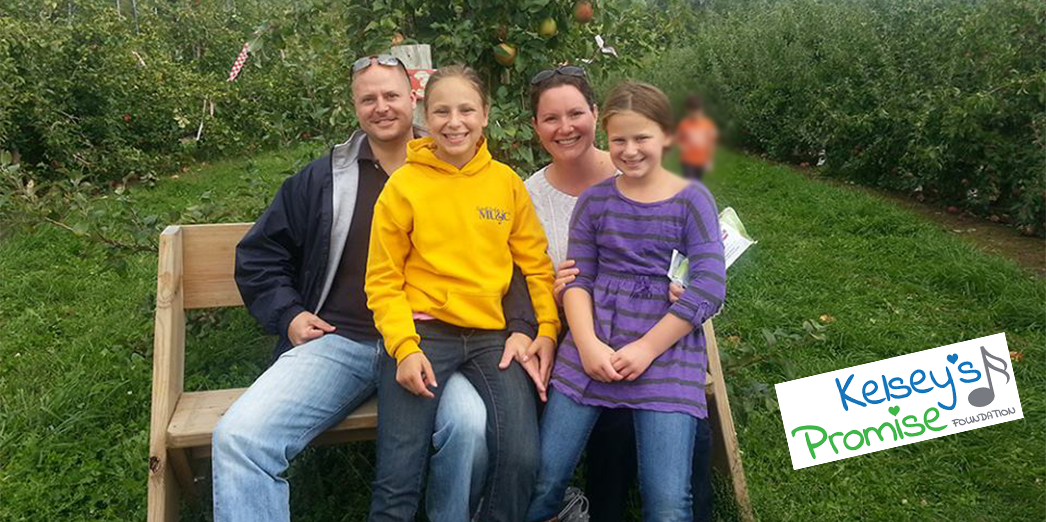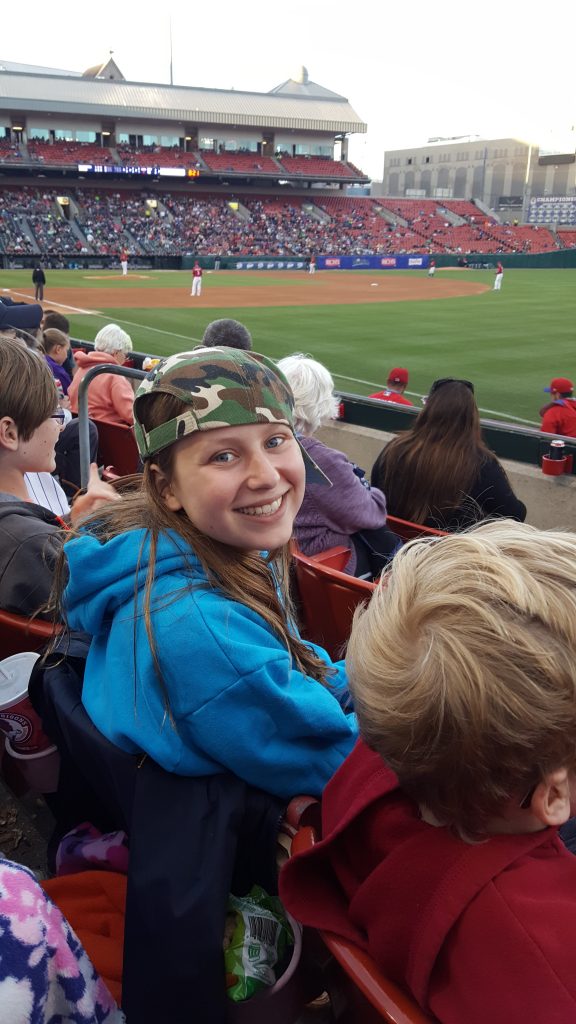Saying Goodbye to Normal

by Rachael Kittleson
Kelsey’s Mom
www.KelseysPromise.org
As normal goes, we were a normal family…two daughters, two dogs, a neighborhood full of kids, family dinners, carpools, homework, and messy rooms. Our oldest daughter Kelsey was a great kid. At 14, she was a high honors student, athlete, musician, and volunteer who loved Journey and Queen, The Big Bang Theory and 80’s movies. She made us proud in a million ways and was by all measures a normal teenager. On August 27, 2015, two weeks before her freshman year was to start, doctors would find a tumor the size of an orange in Kelsey’s brain. In an instant we were permanently and irrevocably removed from normal.
 Surgery would confirm our worst fear, Kelsey had Glioblastoma Multiforme and she would not survive. For the first year Kelsey went through the standard of treatment protocol for GBM that included both radiation and chemotherapy while enduring the physical and emotional hardships they cause. When Kelsey started to decline in the second year, I met with her social worker to begin discussions on making decisions for Kelsey’s final months. There is nothing in life that can prepare you for that conversation and as unimaginable as it was to learn that Kelsey had brain cancer, having to think through what the end of her life would look like and what we would need to plan for was one of the most painful things I have ever experienced. That difficult meeting would, however, give our family a gift that I did not know was an option, but one that I am grateful for every single day.
Surgery would confirm our worst fear, Kelsey had Glioblastoma Multiforme and she would not survive. For the first year Kelsey went through the standard of treatment protocol for GBM that included both radiation and chemotherapy while enduring the physical and emotional hardships they cause. When Kelsey started to decline in the second year, I met with her social worker to begin discussions on making decisions for Kelsey’s final months. There is nothing in life that can prepare you for that conversation and as unimaginable as it was to learn that Kelsey had brain cancer, having to think through what the end of her life would look like and what we would need to plan for was one of the most painful things I have ever experienced. That difficult meeting would, however, give our family a gift that I did not know was an option, but one that I am grateful for every single day.
It is a gift that gives me hope, makes me feel like I have honored Kelsey’s life while giving meaning to what she suffered and lost. It is a gift that makes me feel like we can be part of the solution.
I asked our social worker that day if we could donate Kelsey’s organs; I so desperately wanted Kelsey’s life to make a difference for someone else and, selfishly, I wanted to know that a piece of her was out there, somewhere. Unfortunately due to her treatments, we could not. I was disappointed, but not surprised . Our social worker then mentioned the possibility of donating Kelsey’s tissue for research. After Kelsey’s diagnosis, my husband, a father with an instinctual need to protect and save his daughter, scoured with abandon every possible clinical trial with even a modicum of success hoping to enroll Kelsey. During his unsuccessful journey to find that rare miracle, again and again we were disappointed by the lack of research for pediatric Glioblastoma, even though, as our oncologist explained, pediatric GBM is drastically different from adult GBM on a molecular level.
Every few weeks we would ask Kelsey’s treatment team for the latest list of trials. While there were routinely over 300 for adults, there was never more than a dozen or so for pediatric GBM. So, when offered the opportunity to donate Kelsey’s tissue postmortem, our intense frustration regarding the lack of research and clinical trials available for pediatric Glioblastoma coupled with our desire to create a legacy of giving in Kelsey’s name made the difficult decision an easy one for us.

After Kelsey passed, her brain and spinal tissues were collected and sent to Dana Farber. When I signed papers my one request was that we be given an update on any progress they may have made with her samples. Less than a year after her donation we were contacted by members of the Ligon Lab at Dana Farber. Kelsey’s tissue samples were critical, in fact, for two studies they were preparing to publish. I cried, I rejoiced, I mourned, but mostly I felt so much peace and gratitude. I think about that news every day; that out there somewhere she is making a material difference to advance research to improve treatments.
Of course I wish our life were different and that she was here getting ready to graduate, heading off to college to find her own way to make her mark in this world. But I find comfort in knowing that our donation is contributing to research that I am confident one day will find the cure. She will be part of the answer and someday a family with a young girl will learn their daughter has brain cancer, and they will be told, “we can cure that.” And they will go on to live their normal lives.
Recent Publications from Centers of Excellence
Harmonization of Post-mortem Donations for Pediatric Brain Tumors and Molecular Characterization of Difuse Midline Gliomas
Children diagnosed with brain tumors have the lowest overall survival of all pediatric cancers. To address the paucity of tissue for biological studies, we have established a comprehensive protocol for the coordination and processing of donated specimens at postmortem. Since 2010, 60 postmortem pediatric brain tumor donations from 26 institutions were coordinated and collected. Patient derived xenograft models and cell cultures were successfully created (76% and 44% of attempts respectively), irrespective of postmortem processing time. Histological analysis of mid-sagittal whole brain sections revealed evidence of treatment response, immune cell infiltration and the migratory path of infiltrating H3K27M DMG cells into other midline structures and cerebral lobes. Sequencing of primary and disseminated tumors confirmed the presence of oncogenic driver mutations and their obligate partners. Our findings highlight the importance of postmortem tissue donations as an invaluable resource to accelerate research, potentially leading to improved outcomes for children with aggressive brain tumors. Read Full Publication
 Dr. Monje-Deisseroth and her team at Stanford University recently published a paper detailing how gliomas are able to “hijack” the brain's communication system.
Dr. Monje-Deisseroth and her team at Stanford University recently published a paper detailing how gliomas are able to “hijack” the brain's communication system.
Published in Nature: High-grade gliomas are lethal brain cancers whose progression is robustly regulated by neuronal activity. Activity-regulated release of growth factors promotes glioma growth, but this alone is insufficient to explain the effect that neuronal activity exerts on glioma progression. Here we show that neuron and glioma interactions include electrochemical communication through bona fide AMPA receptor-dependent neuron–glioma synapses. Read More

Congratulations to two of our Center of Excellence teams lead by Dr Javad Nazarian and Dr. Michelle Monje on their recent groundbreaking research publication. Due in part to increased access to post-mortem tissue the teams were able to study a larger sample of DIPG tumors. Diffuse intrinsic pontine glioma is a lethal pediatric brain cancer characterized by H3K27M histone mutation. Nagaraja et al. characterize a large cohort of rare primary tumors and normal pontine tissue to reveal active regulatory element heterogeneity dependent upon the histone variant and cell context in which the mutation occurs. Read More
the teams were able to study a larger sample of DIPG tumors. Diffuse intrinsic pontine glioma is a lethal pediatric brain cancer characterized by H3K27M histone mutation. Nagaraja et al. characterize a large cohort of rare primary tumors and normal pontine tissue to reveal active regulatory element heterogeneity dependent upon the histone variant and cell context in which the mutation occurs. Read More
Research Breakthroughs Resulting from Autopsy Tissue
Donovan_et_al_Locoregional_delivery_CAR-T_cells_Nat_Med2020_opt
Potent antitumor efficacy of anti-GD2 CAR T cells in H3-K27M+ diffuse midline gliomas_2018
Non-inflammatory tumor microenvironment of diffuse intrinsic pontine glioma_2018
Intertumoral Heterogeneity within Medulloblastoma Subgroups_Sick Kids Publication_June 2017
A Protocol for Rapid Post-mortem Cell Culture of Diffuse Intrinsic Pontine Glioma (DIPG)_March 2017
Neural Precursor-Derived Pleiotrophin Mediates Subventricular Zone Invasion by Glioma_Aug 2017
Divergent clonal selection dominates medulloblastoma at recurrence
Models Pave the Way for Improved Outcomes in Medulloblastoma_August 2016
Functionally defined therapeutic targets in diffuse intrinsic pontine glioma_June 2015
Neuronal Activity Promotes Glioma Growth through Neuroligin-3 Secretion_May 2015 Cell
Stanford Research Paper: Electrical and synaptic integration of glioma into neural circuits
Rapid autopsy of a patient with recurrent anaplastic ependymoma.
Next-Generation Rapid Autopsies Enable Tumor Evolution Tracking and Generation of Preclinical Models
Why Autopsy Tissue is Needed to Empower Research
Pediatric Brain Cancer Tissue Donation article_2016
Overcoming Autopsy Barriers in Pediatric Cancer Research
Study on Collection of autopsy tissue in DIPG patients_Oct 2010
Next-Generation Rapid Autopsies Enable Tumor Evolution Tracking_January 2018
The clinical, research, and social value of autopsy after any cancer death
Gift from a Child
Is a Swifty Foundation Program
Swifty is a recipient of the GuideStar Gold Seal of Transparency






